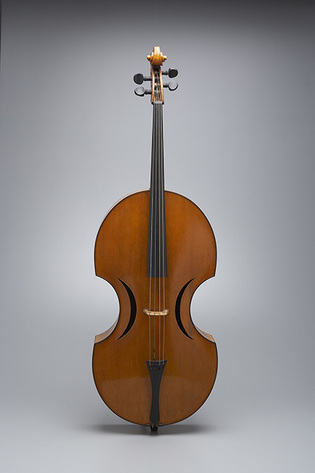 loading
loading
Arts & CultureA cello ahead of its timeObject lesson: An innovative design, but it “really didn’t fulfill a purpose.” Matthew Guerrieri, a writer, composer, and pianist who writes for the Boston Globe, is the author of The First Four Notes: Beethoven’s Fifth and the Human Imagination.  Yale Collection of Musical Instruments/Gift of G. H. LangzettelIt looks like art deco. But it’s much, much older. This unusual cello—by an unusual maker—was donated to the university by Yale professor of drawing George H. Langzettel, an 1898 Yale BFA who played violin in the New Haven Symphony. View full imageIt looks at least a century removed from its true era—a lean art deco relic that somehow turned up in 1828 Vienna. It is a cello in Yale’s Collection of Musical Instruments, built by Johann Georg Stauffer. The body is nearly symmetrical, the bridge placed at the exact center. The soundholes are slivered moons instead of the familiar f-shaped curls. It is the work of a habitual inventor whose career was eventually derailed by his penchant for tinkering with tradition. Guitars were Johann Georg Stauffer’s forte, and a target of his creativity. He made the fingerboard longer and skinnier, the body larger. He invented a turnkey mechanism to pivot the guitar’s neck and fingerboard up or down to suit a player’s preference. Guitars from his Vienna workshop were copied for decades; even today, many of Stauffer’s innovations remain in use. “He was a genius,” says Andrew Dipper, the Yale collection’s conservator of string instruments. Stauffer might have flourished had he remained focused on the guitar. But he didn’t. He grafted his key-adjustable neck onto the cello, garnering press notice but few sales. He built another cello-like instrument, with six strings, tuned like a guitar—the arpeggione, a curiosity elevated to footnote status only by the fact that Franz Schubert himself wrote a sonata for it. Stauffer and a partner patented a “Hohlflügel,” a piano with a semi-circular keyboard and tapered keys, “by which all pianists, especially children, can obtain special relief.” No example survives. And then there was Stauffer’s improved cello. He adapted a design published in 1808 by Johann Conrad Wilhelm Petiscus, a Leipzig preacher and music enthusiast. Building on then-novel scientific advances (especially, Dipper notes, the work of German physicist Ernst Chladni), the theory was that a shape with as many long, uninterrupted wood fibers as possible might yield a richer sound. Dipper also places Stauffer in a larger, general wave of early-1800s innovation: “There was a huge jump in new forms of design.” Stauffer built at least two violins along with the cello, and he and his son obtained a patent for their updated design in 1828. But, after a few years, they let the patent lapse. Business was faltering. The expense of Stauffer’s experiments had left the family firm in considerable debt; Stauffer turned the company over to his son and retired. He died in 1853, two days before his 65th birthday. Guitars continued to evolve along Stauffer’s lines well into the twentieth century. Orchestral string instruments, though, still genuflect to their eighteenth-century Italian ancestors: Amati, Guarnieri, Stradivarius. Why? In practical terms of sound production, Stauffer’s changes were subtle—maybe too subtle. Unlike keyboard instruments, which required profound changes to keep up with new styles and tuning systems, Stauffer’s violin and cello “really didn’t fulfill a purpose,” explains Arian Sheets, curator at the National Music Museum in South Dakota (which possesses one of Stauffer’s violins). She also points out that orchestral instruments were more adaptable: players could customize and repair the strings, neck, bridge, or tailpiece on an old instrument, but “guitars have a lot fewer things to modify.” A guitarist would more likely simply buy a new guitar. Moreover, Stauffer’s cello appeared a year after the death of Beethoven, and the same year as that of Schubert. He was trying to change classical music at the historical moment when it was solidifying into a repertoire and a traditional practice—an art form in constant acknowledgement of and recreation of its past. His cello exemplified a parallel but opposite human tradition: restlessness.
The comment period has expired.
|
|